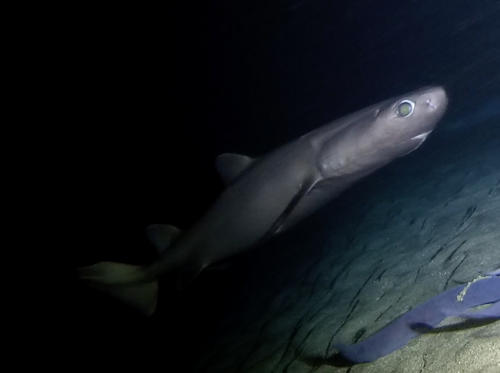
Kitefin Shark
The Atlantic bluefin tuna (Thunnus thynnus) is one of the largest and fastest bony fish in the world's oceans. Known for its incredible migrations and commercially valuable meat. It has a unique physiology. This species plays a crucial role in the marine ecosystem.
Unknown Unknown years
Lifespan
100 - 140 cm
Length
Vulnerable
Conservation Status
Unknown km/h
Swimming speed
Carnivorous, Scavengers
Diet
Local Migration
Migration
Appearance Overview
The Atlantic bluefin tuna is a large, torpedo-shaped fish with a streamlined body built for speed and endurance.
Color
Dark metallic blue on top with a silvery underside
Fins
Two dorsal fins, the first depressible; small finlets running from dorsal and anal fins to the tail
Body
Streamlined, fusiform body shape
Length
up to 13 feet (4 meters)
Weight
up to 2,000 lbs (907 kg)
Diet
Carnivorous, feeding on a variety of fish, squid, crustaceans, and eels.
Feeding Behavior
Highly active predator that uses its speed and agility to hunt. They often hunt cooperatively, herding and trapping prey.
Social Behavior
Forms large schools, often segregated by size. Highly migratory, capable of crossing entire oceans.
Commercial Relevance
Extremely high value, especially in sushi and sashimi markets, where a single fish can sell for thousands or even millions of dollars.
Conservation measures
Subject to international fishing quotas and regulations, marine protected areas, and efforts to reduce bycatch.
Status
Endangered (Varies by population segment; some are considered critically endangered)
Threats
Overfishing (historically and ongoing), bycatch in other fisheries, habitat degradation, and climate change.
Habitat Distribution
Depth Range
0-1,000 meters (typically in the upper layers of the ocean)
Geographic Range
Atlantic Ocean, Mediterranean Sea, and formerly in the Black Sea
Preferred Environment
Temperate and subtropical waters, open ocean and coastal areas
Reproduction and Life Cycle
Breeding Habits
Spawns in warm waters, with two main spawning grounds: the Mediterranean Sea and the Gulf of Mexico. Spawning typically occurs from May to July.
Development Stages
Eggs hatch into larvae, which drift as plankton. Juveniles grow rapidly, feeding and developing in nutrient-rich waters. They eventually join schools and begin their long migrations.
Fecundity
Females are highly fecund, capable of producing up to 30 million eggs per spawning season.
Maturity Age
Matures at 4-8 years, depending on the population and environmental conditions.
Faqs about Kitefin Shark
Where are Atlantic bluefin tuna found?
Atlantic bluefin tuna are found in the Atlantic Ocean, ranging from Newfoundland to the Gulf of Mexico in the west, and from Norway to the Mediterranean Sea in the east.
How long do bluefin tuna live?
They can live up to 40 years.
Are bluefin tuna warm-blooded?
Yes, they are warm-blooded, which is unusual for fish. They have a specialized circulatory system that allows them to maintain a body temperature higher than the surrounding water.
What do Atlantic Bluefin Tuna eat?
Atlantic bluefin tuna primarily feed on smaller fish like herring, mackerel, and squid.
Why are they endangered?
Overfishing is the biggest threat, driven by high demand in the sushi market.
How fast can they swim?
They can swim at speeds up to 43 mph (70 km/h) in short bursts.
How many eggs can a female bluefin tuna lay?
Females can release millions of eggs during spawning season, up to 30 million.
Why is their meat so valuable?
Bluefin tuna meat is prized for its flavor, texture, and high fat content, making it ideal for sushi and sashimi.
When do they reach maturity?
They reach sexual maturity between 4-8 years of age.
Do they migrate?
They undertake long migrations, often crossing the Atlantic Ocean, for feeding and spawning.
Copyright @ Nature Style Limited. All Rights Reserved.
 English
English